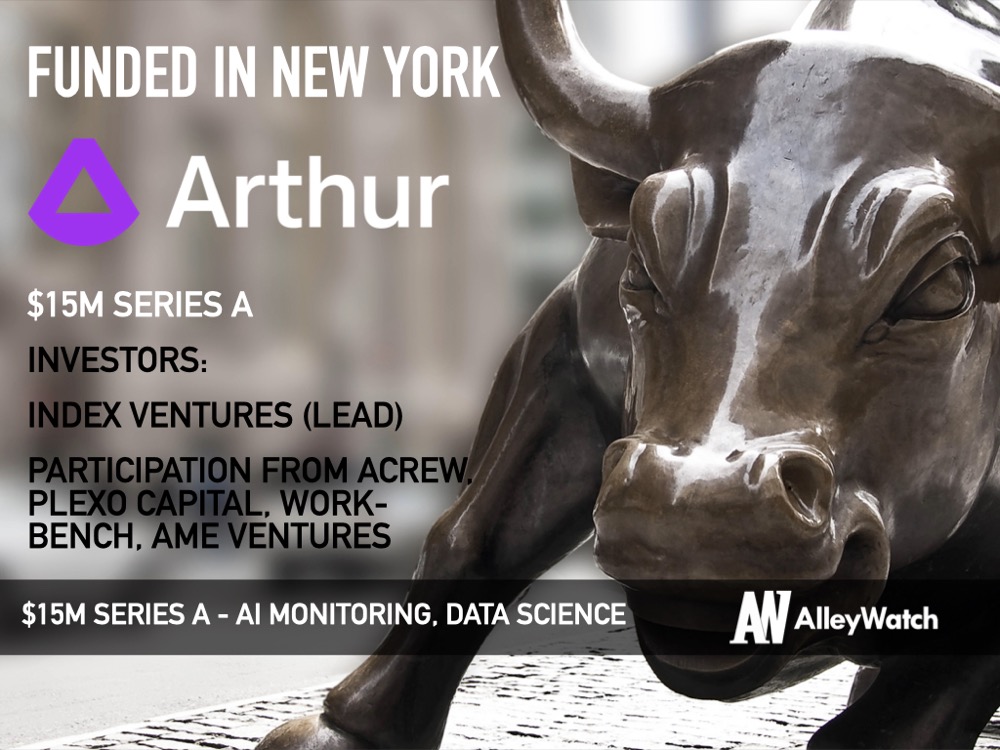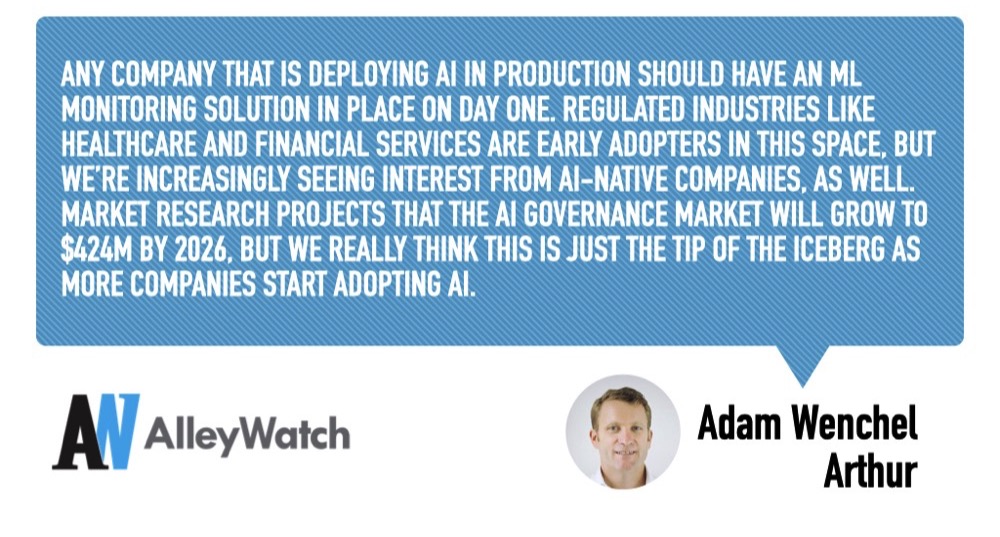The AI software market is expected to grow 54% per annum over the next several years according to Statista. As the evolution of AI continues, challenges do remain especially when it comes to the effects of bias in models. Arthur is a comprehensive monitoring solution, fairness assessment tool, and model management platform that allows firms to gain oversight and control of their machine learning systems. The platform gives companies the confidence that they are scaling with visibility as a simple mistake can become catastrophic as AI-powered models scale. Founded in 2018, Arthur’s technology has been deployed at organizations like Humana, Bloomberg, Truebill, and the US Air Force and the company is growing very fast with revenue up 300% in the last six months alone.
AlleyWatch caught up with Cofounder and CEO Adam Wenchel to learn more about the importance of AI monitoring, the company’s future plans, and latest round of financing, which brings the total funding raised to $18.3M.
Who were your investors and how much did you raise?
Arthur just raised a $15 million Series A funding round led by Index Ventures with participation from Acrew and Plexo Capital. We’re also pleased that all of our existing investors, Homebrew, Work-Bench, and AME Ventures, decided to double down in this round.
 Tell us about the product or service that Arthur AI offers.
Tell us about the product or service that Arthur AI offers.
Arthur is a proactive model monitoring solution that gives data science teams the confidence that their AI deployments are performing as expected, and the peace of mind that they can catch and fix issues before they derail models. No matter where models are deployed, Arthur brings them all into view in a centralized platform. With advanced performance monitoring, bias detection, and customizable alerts, you’ll never miss an issue; and Arthur’s explainability engine makes debugging a breeze with prediction-level explanations, even for black-box models.
What inspired the start of Arthur AI?
Our founding team has combined 50+ years of enterprise AI experience. In our previous roles as enterprise AI leaders, we needed visibility into the large-scale systems we had built. We understood the importance of getting alerted to issues before small inaccuracies become million-dollar problems. We’ve seen firsthand that algorithmic bias and data drift are unavoidable, but that AI observability tools can help teams detect and combat these issues before their models start behaving badly.
Our desire for these tools is part of a growing trend. Since we started Arthur, the market has become more and more aware of the need for better oversight and control over their machine learning systems. Public incidents exposing the dangers of AI bias, including issues with OpenAI’s GPT-3 and face detection failures from Twitter and Zoom, have made it clear that continuous bias monitoring and mitigation are essential for any organization looking to deploy AI. The pandemic has sent many organizations’ models into a tailspin, due to unexpected behaviors like concept or data drift. They now know—some having learned the hard way—that they can’t scale their AI operations without the right controls in place.
How is Arthur AI different?
Because ML monitoring is our singular focus, our tools go well beyond what the major cloud providers offer—we allow for greater customization of monitoring and alerting. We also are platform-agnostic; we don’t care where your models are deployed, we’ll bring all of your monitoring into a single dashboard so you don’t have to switch between tools. This is a major differentiator and key for organizations that have models deployed across lots of different platforms and places, from AWS to Azure to on-prem in their data centers.
What market does Arthur AI target and how big is it?
Any company that is deploying AI in production should have an ML monitoring solution in place on day one. Regulated industries like healthcare and financial services are early adopters in this space, but we’re increasingly seeing interest from AI-native companies, as well. Market research projects that the AI governance market will grow to $424M by 2026, but we really think this is just the tip of the iceberg as more companies start adopting AI.
What’s your business model?
We sell software through both a SaaS and an on-prem model. When helpful we also partner more deeply with organizations via expert workshops and white glove services.
How has COVID-19 impacted the business?
The silver lining of COVID-19 for Arthur has been a dramatic increase in demand. The pandemic has created a huge acceleration in the move to digital services. On top of that, the massive shift in consumer habits has wreaked havoc on many machine learning models that were trained on historical data that now looks wildly different from the way the world is today. We’ve seen our revenue grow 300% in the last six months, and much of this is due to growing market demand for tools that can help detect and fix issues like data drift and algorithmic bias.
What was the funding process like?
Pursuing funding is a bit of a distraction from a startup’s most important work — making sure their customers are insanely happy. But we were fortunate that there is a lot of interest in AI and in particular our focus areas. Consequently, we were able to be very targeted and work with our favorite investors!
What are the biggest challenges that you faced while raising capital?
Selecting the right partners on any journey is a supremely important challenge. We were very important to have longstanding relationships with the teams at Index and other key investors. One of the challenges we undertook in our latest investment round was to build a very diverse group of investors. Given our work, diversity at all levels is an existential issue. It took a bit of extra legwork, but it was well worth it — we couldn’t be happier with the team we have backing us!
2021 NYC TECH INFLUENCERS | DEADLINE 1/15
NOMINATE NOW
What factors about your business led your investors to write the check?
Our investors, first and foremost, believe strongly in our product, our team, and our mission. The people who choose to join you on the journey ultimately determine your success. We are very grateful for the team that has come together at Arthur.
Mike Volpi, our lead investor from Index, talks about is how he appreciates that our team is comprised of “practitioner-entrepreneurs”—we’ve been in the trenches in our previous roles and faced the problems that we’re trying to solve with Arthur.
What are the milestones you plan to achieve in the next six months?
We’re going to be using this investment to scale our operations and our team. One of our biggest goals over the next six months is to hire people in a few key roles—we need to grow our sales and marketing teams, and we also need to hire more engineers. We’ve been able to achieve a lot with our small, scrappy team, but it’s time to move to the next phase of growth.
We’re going to be using this investment to scale our operations and our team. One of our biggest goals over the next six months is to hire people in a few key roles—we need to grow our sales and marketing teams, and we also need to hire more engineers. We’ve been able to achieve a lot with our small, scrappy team, but it’s time to move to the next phase of growth.
We have some really cool capabilities coming out that enable teams doing work in unstructured data — NLP and Computer Vision in particular — to deploy their models with confidence. Monitoring drift, explaining predictions, and protecting against unintentional bias in those cases requires a whole new way of thinking about ML. We’re fortunate to have the right people on the team to address these challenges!
What advice can you offer companies in New York that do not have a fresh injection of capital in the bank?
We bootstrapped for the first 6 months and were accidentally profitable. Investment capital is the byproduct of building a viable business, not a goal.
Where do you see the company going now over the near term?
Right now, we’re 17 people. At this time next year, we expect to be more than double that in size. Send talented people our way!
What’s your favorite outdoor dining restaurant in NYC
Have to represent the LES and go with grabbing takeout from Wah Fung No 1 and sitting on the benches across the street to watch the handball games.”





